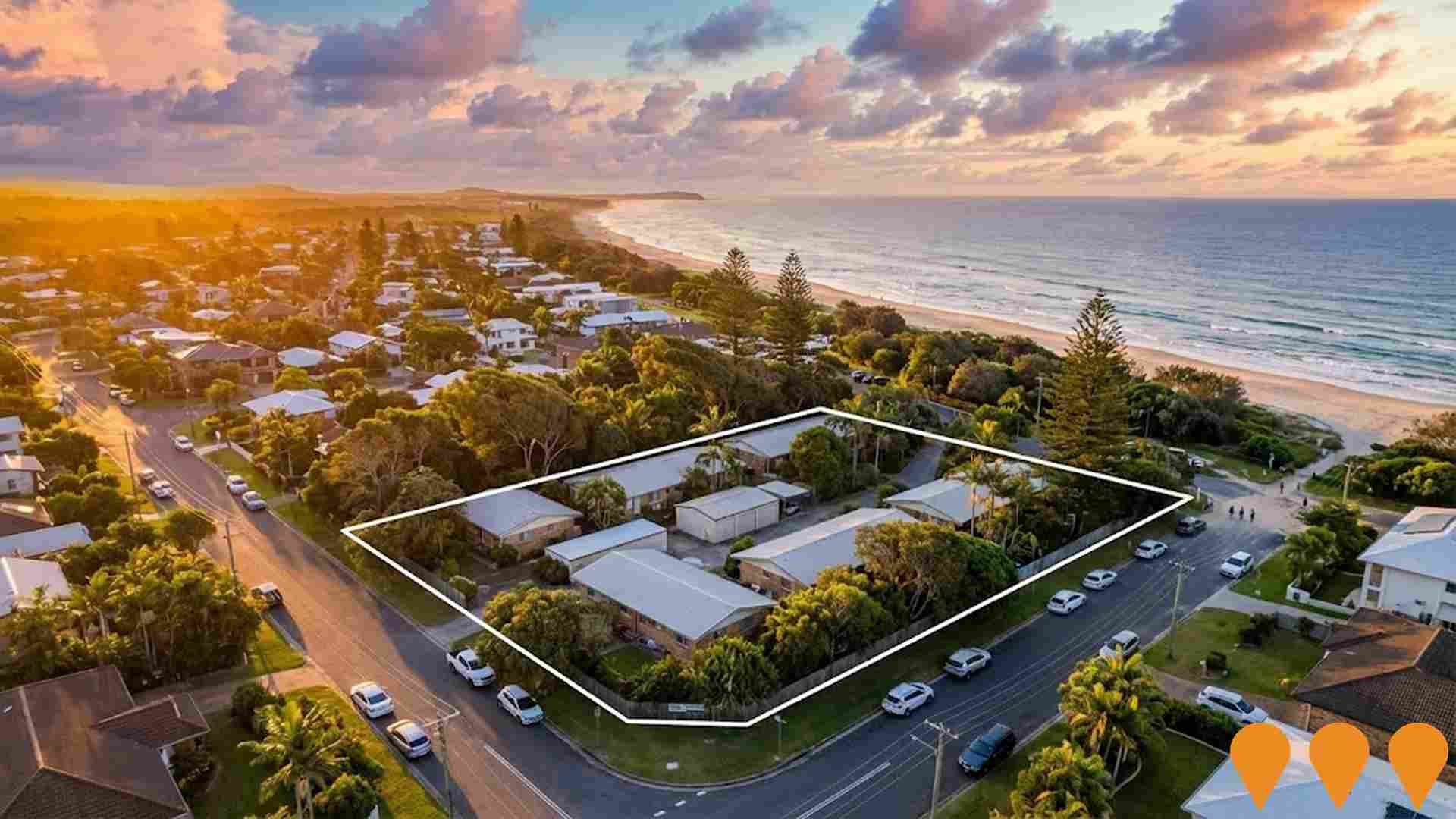Chart Color Schemes
est. as @ -- *
ABS ERP | -- people | --
2021 Census | -- people
Sales Activity
Curious about local property values? Filter the chart to assess the volume and appreciation (including resales) trends and regional comparisons, or scroll to the map below view this information at an individual property level.
Find a Recent Sale
Sales Detail
Population
Byron Bay lies within the top quartile of areas nationally for population growth performance according to AreaSearch analysis of recent, and medium to long-term trends
Byron Bay's population is approximately 11,379 as of November 2025. This figure represents an increase of 465 people since the 2021 Census, which recorded a population of 10,914. The growth was inferred from ABS estimates and validated new addresses between June 2024 and the Census date. The population density is around 286 persons per square kilometer. Byron Bay's growth rate of 4.3% since the 2021 census surpassed the SA4 region's 3.3%, indicating it as a growth leader in the area. Overseas migration contributed approximately 91.7% of overall population gains during recent periods.
AreaSearch uses ABS/Geoscience Australia projections for each SA2 area, released in 2024 with a base year of 2022, and NSW State Government's SA2 level projections for areas not covered by this data, released in 2022 with a base year of 2021. These projections estimate Byron Bay's population to increase by 1,144 persons to 2041, recording an 8.7% gain over the 17 years.
Frequently Asked Questions - Population
Development
AreaSearch assessment of residential approval activity sees Byron Bay among the top 30% of areas assessed nationwide
Byron Bay has recorded approximately 75 residential properties granted approval annually. Over the past five financial years, from FY21 to FY25, around 375 homes were approved, with an additional 39 approved so far in FY26. On average, about 1.3 new residents have arrived per year for each new home constructed over these five years, indicating a balanced supply and demand market that supports stable conditions.
The average construction cost value of new properties is $850,000, suggesting developers are focusing on the premium market with high-end developments. This financial year has seen $54.9 million in commercial development approvals, reflecting robust local business investment. Compared to the rest of NSW, Byron Bay has slightly more development activity, at 15.0% above the regional average per person over the past five years.
This preserves reasonable buyer options while sustaining existing property demand. Recent construction comprises 52.0% detached dwellings and 48.0% attached dwellings, showing an expanding range of medium-density housing options that cater to different price brackets. The location has approximately 138 people per dwelling approval, indicating a low density market. Future projections suggest Byron Bay will add around 989 residents by 2041. With current construction levels, housing supply should adequately meet demand, creating favourable conditions for buyers and potentially enabling growth that exceeds current forecasts.
Frequently Asked Questions - Development
Infrastructure
Byron Bay has strong levels of nearby infrastructure activity, ranking in the top 30% nationally
Changes to local infrastructure significantly influence an area's performance. AreaSearch has identified 26 projects likely impacting the region. Notable initiatives include 29 Shirley Street Apartments, Byron Bay Drainage Upgrade, Bohemian Byron Bay, and Tennyson Street Upgrade. The following list details those expected to be most relevant.
Professional plan users can use the search below to filter and access additional projects.
INFRASTRUCTURE SEARCH
 Denotes AI-based impression for illustrative purposes only, not to be taken as definitive under any circumstances. Please follow links and conduct other investigations from the project's source for actual imagery. Developers and project owners wishing us to use original imagery please Contact Us and we will do so.
Denotes AI-based impression for illustrative purposes only, not to be taken as definitive under any circumstances. Please follow links and conduct other investigations from the project's source for actual imagery. Developers and project owners wishing us to use original imagery please Contact Us and we will do so.
Frequently Asked Questions - Infrastructure
Mercato on Byron
Completed lifestyle retail and entertainment precinct anchored by Woolworths and a nine-screen Palace Cinemas, with sustainable features including a 5 Star Green Star rating, rooftop solar, and water harvesting.
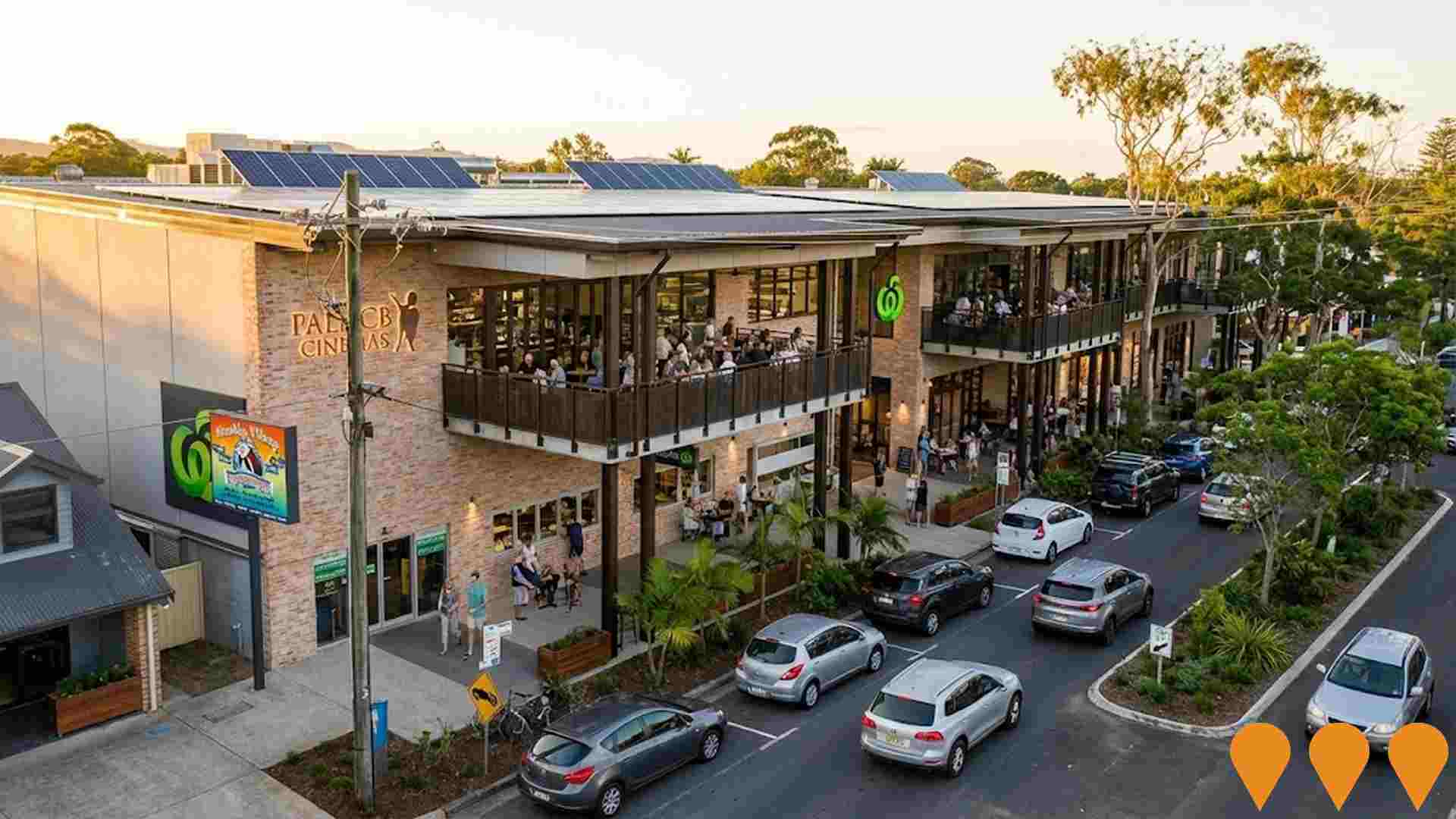
Byron Bay Drainage Upgrade
Stage 1 works to upgrade town centre drainage to reduce flooding impacts across Byron Bay. Scope includes new trunk drainage in Byron Street and parts of Jonson Street, works in the Lawson Street South car park and rail corridor, plus associated road and footpath upgrades, tree planting and seating. Subsequent stages (Fletcher Street and other catchments) subject to funding.
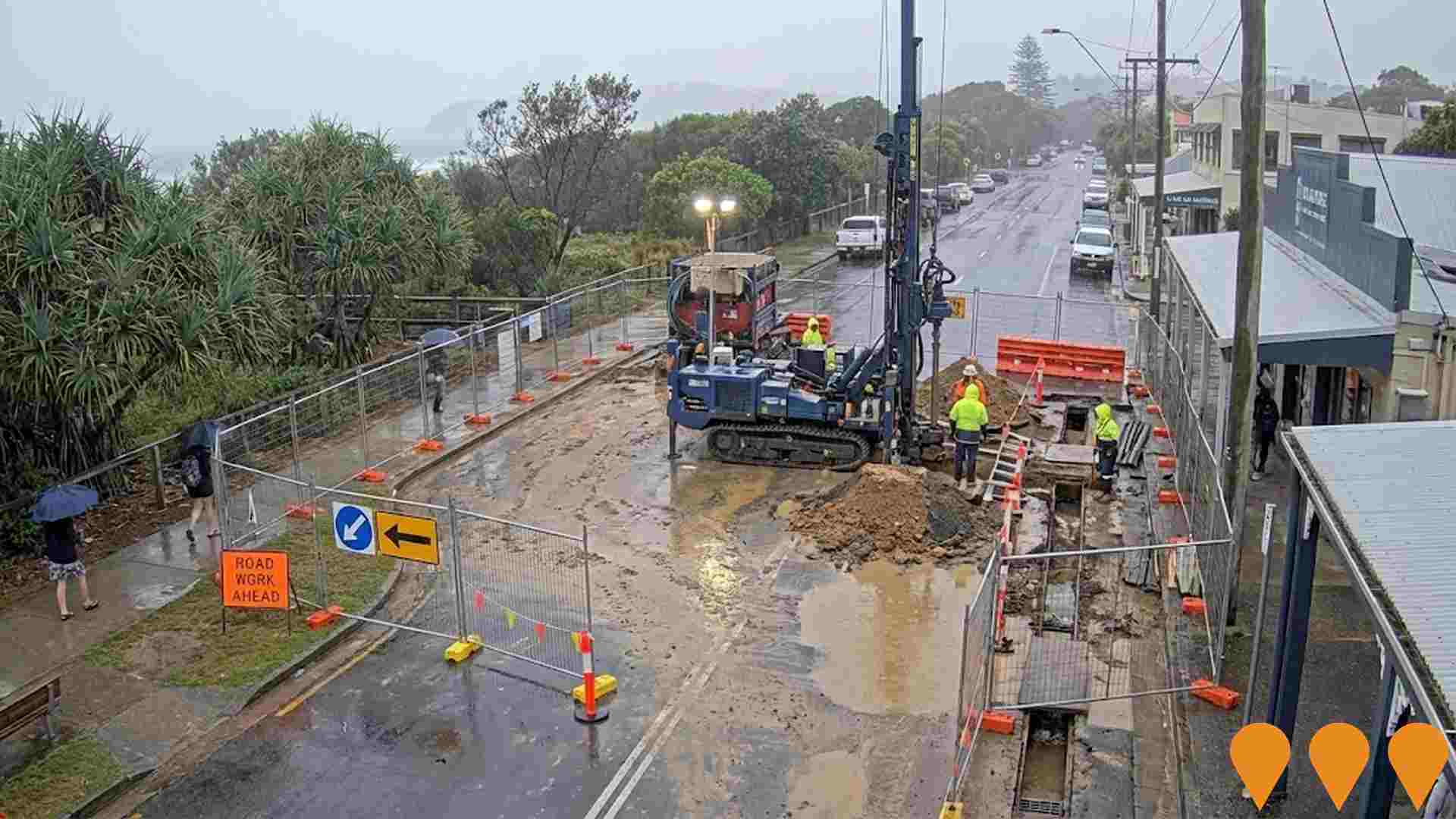
Kool Beanz Academy Childcare Centre
A boutique childcare centre designed to provide a nurturing, nature-inspired environment for children aged six weeks to five years. The centre features three intimate classrooms, a mud kitchen, a bird aviary, and a yarning circle. It is designed, built, owned, and managed by Coulson Operations.

29 Shirley Street Apartments
Demolition of backpackers hostel and construction of 26 three-bedroom luxury apartments across three boutique buildings by Vitale Property Group. Features pool, gym, sauna, meeting rooms and 8-star environmental certification with EV chargers and photovoltaic panels. Each unit includes three carparks.
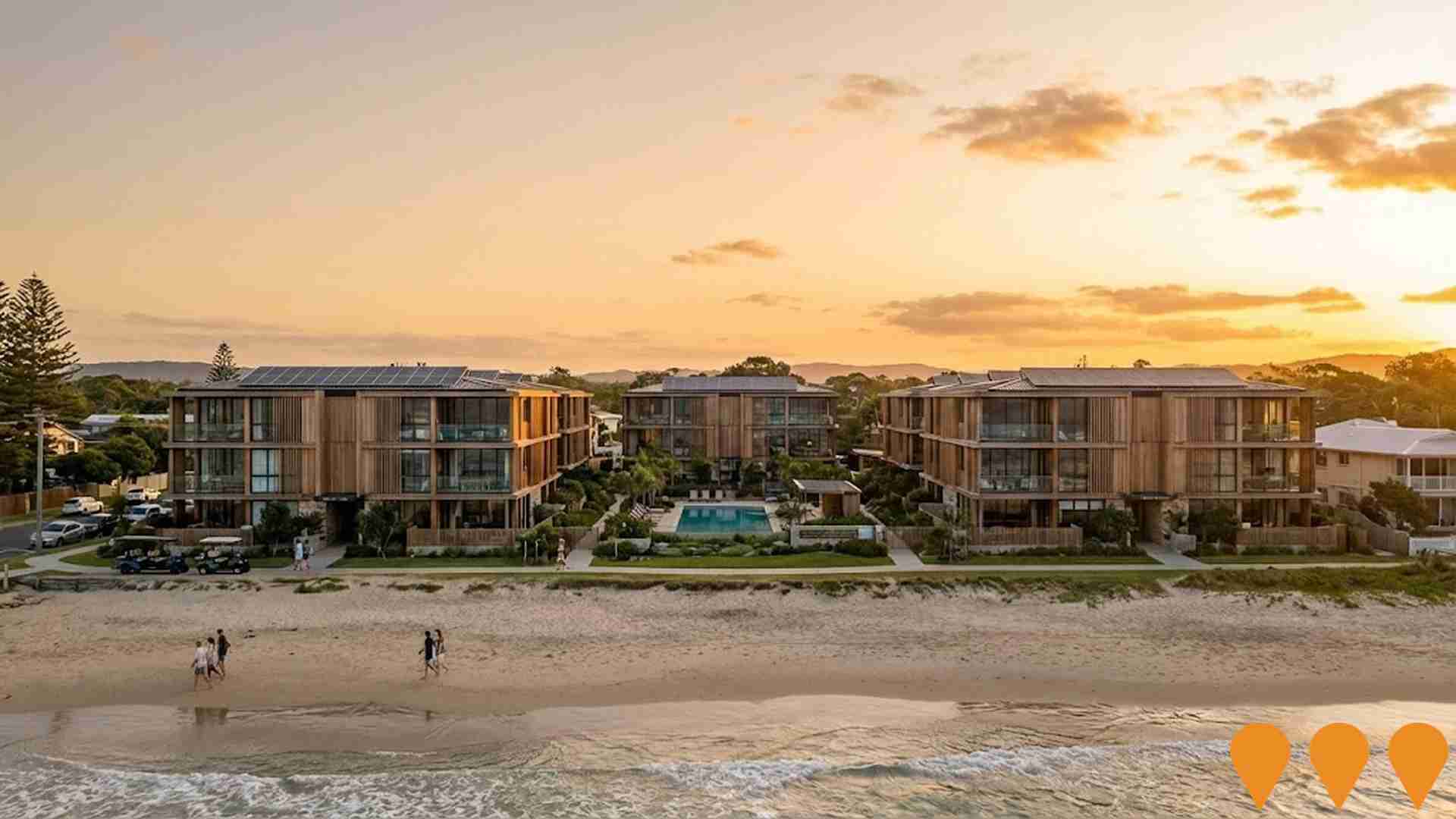
Bohemian Byron Bay
Mixed-use redevelopment of the former Byron Plaza site by Luxcon Group with 44 two and three bedroom apartments designed by PBD Architects and interiors by Coco Republic. The project includes a rooftop pool club with 25 m heated pool, gym, spa and sauna, plus ground-floor retail and a hawker-style food lane inspired by Spice Alley. Consent was issued by the Northern Regional Planning Panel with a later modification reducing dwellings to 44; Luxcon lists an indicative completion of 2026.
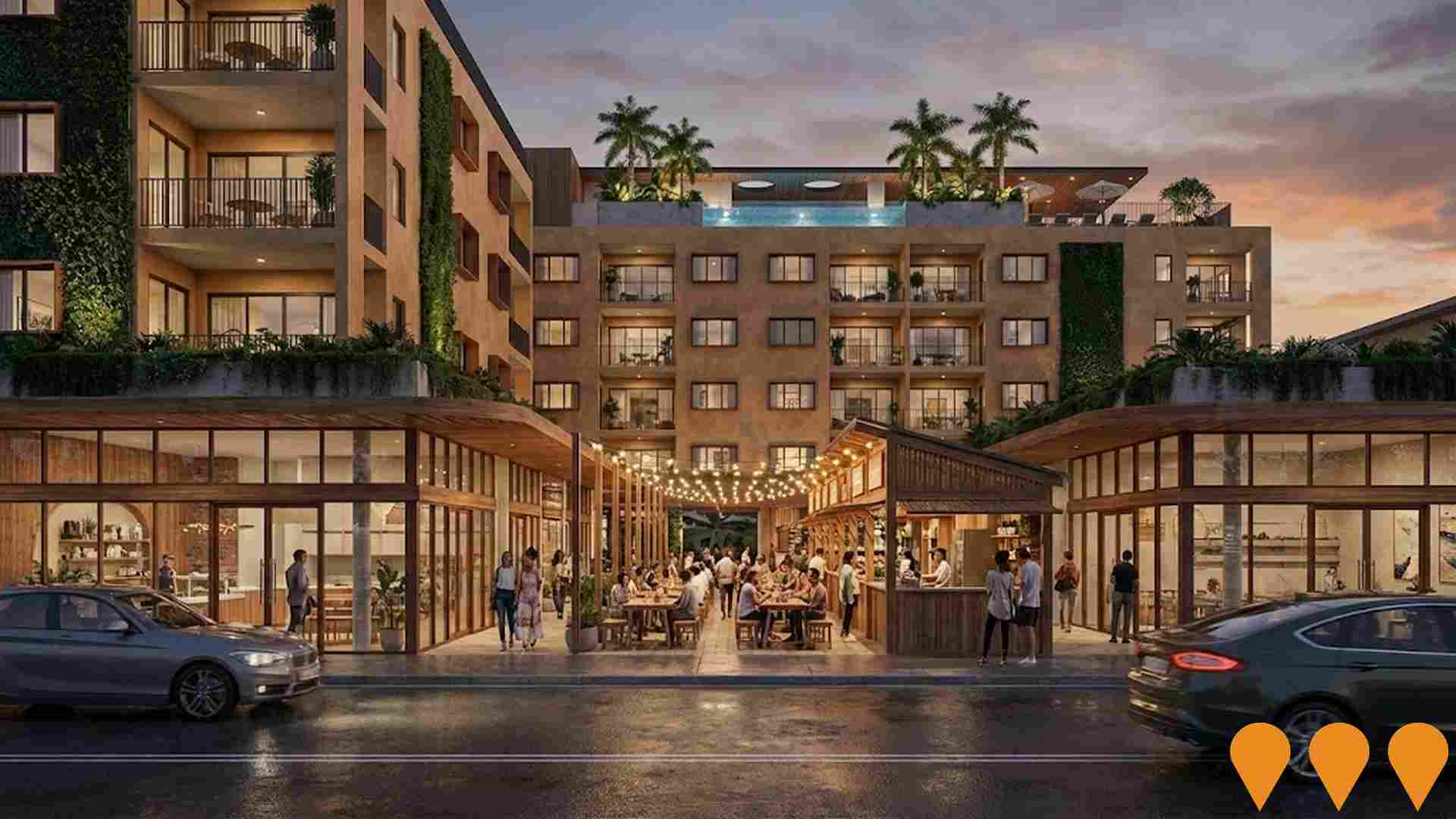
Coogera Circuit Detention Basin Upgrade
This project involved upgrading the Coogera Circuit Detention Basin in Suffolk Park to reduce the risk of flooding after major rainfall events. The work included raising the basin wall, improving stormwater drainage, and demolishing old infrastructure. The upgrade significantly improved flood protection, benefiting over 100 properties in the area. It increased the basin's flood resilience capacity from a 20% Annual Exceedance Probability (AEP) to a 2% AEP, benefiting approximately 80 properties. The project was funded primarily by the Australian Government's Emergency Response Fund with an additional contribution from the Byron Shire Council.

41 Bottlebrush Crescent Residential Subdivision
A 16-lot residential subdivision on an ecologically sensitive site in Suffolk Park, NSW. The project focused on sustainable urban design, including innovative stormwater management to address flooding issues, and the preservation of rare and endangered flora and fauna. The development has been registered and is ready for building.

Tennyson Street Upgrade
Council has extended Tennyson Street to connect with Gilmore Crescent near the Byron Bay Skate Park to support a future NSW emergency services precinct. Road construction finished in July 2025, with opening pending completion of lighting, line marking and signage. The upgrade improves pedestrian and cycle links through the Sandhills precinct and adds 33 new parking spaces.
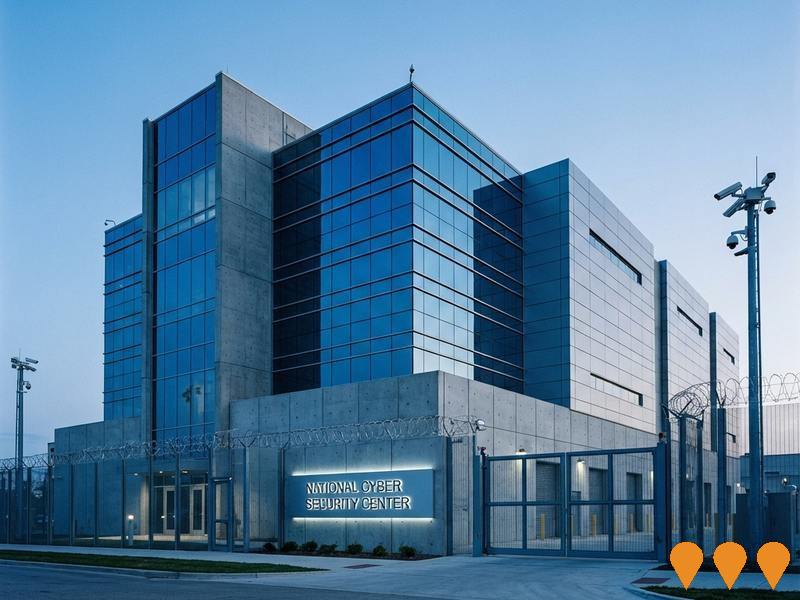
Employment
AreaSearch assessment positions Byron Bay ahead of most Australian regions for employment performance
Byron Bay has a highly educated workforce with tourism and hospitality prominent. As of June 2025, unemployment stands at 2.5%.
In comparison to Rest of NSW's 3.7%, Byron Bay's rate is 1.2% lower. Workforce participation in Byron Bay is 61.1%, slightly higher than Rest of NSW's 56.4%. Leading industries are accommodation & food, health care & social assistance, and professional & technical services. Notably, accommodation & food employment is at 2.8 times the regional average.
Conversely, public administration & safety has only 2.3% of Byron Bay's workforce compared to Rest of NSW's 7.5%. The worker-to-resident ratio in Byron Bay is 0.7, indicating above-average local job opportunities. From June 2024 to June 2025, labour force levels decreased by 4.8%, with employment decreasing by 4.5% and unemployment falling by 0.3 percentage points. In contrast, Rest of NSW saw employment decline of 0.1% and labour force growth of 0.3%, resulting in a 0.4 percentage point rise in unemployment. Jobs and Skills Australia's national employment forecasts from May 2025 project overall employment growth of 6.6% over five years and 13.7% over ten years. Applying these projections to Byron Bay's industry mix suggests local growth of approximately 6.7% over five years and 13.7% over ten years, assuming constant population ratios.
Frequently Asked Questions - Employment
Income
Income levels sit below national averages according to AreaSearch assessment
AreaSearch's latest postcode level ATO data for financial year 2022 shows median income in Byron Bay at $40,571 and average income at $84,268. In comparison, Rest of NSW has a median income of $49,459 and an average income of $62,998. Based on Wage Price Index growth of 12.61% since financial year 2022, estimated incomes as of September 2025 would be approximately $45,687 (median) and $94,894 (average). Census 2021 income data indicates that Byron Bay's household, family, and personal incomes cluster around the 53rd percentile nationally. Income distribution shows that 30.6% of locals (3,481 people) fall within the $1,500 - 2,999 category, similar to the broader area where 29.9% occupy this range. Housing affordability pressures are severe in Byron Bay, with only 78.6% of income remaining, ranking at the 44th percentile. The area's SEIFA income ranking places it in the 7th decile.
Frequently Asked Questions - Income
Housing
Byron Bay displays a diverse mix of dwelling types, with a higher proportion of rental properties than the broader region
Byron Bay's dwelling structures, as per the latest Census, were 62.3% houses and 37.7% other dwellings (semi-detached, apartments, 'other' dwellings), contrasting with Non-Metro NSW's 75.1% houses and 24.9% other dwellings. Home ownership in Byron Bay stood at 36.3%, with mortgaged dwellings at 25.6% and rented ones at 38.1%. The median monthly mortgage repayment was $2,340, surpassing Non-Metro NSW's average of $1,980. Median weekly rent in Byron Bay was $620, higher than Non-Metro NSW's $450. Nationally, Byron Bay's mortgage repayments were significantly higher at $2,340 compared to the Australian average of $1,863, and rents were substantially above the national figure of $375.
Frequently Asked Questions - Housing
Household Composition
Byron Bay features high concentrations of group households, with a fairly typical median household size
Family households constitute 58.4% of all households, including 21.4% couples with children, 26.7% couples without children, and 9.5% single parent families. Non-family households account for the remaining 41.6%, with lone person households at 29.1% and group households comprising 12.5%. The median household size is 2.4 people, which aligns with the average for the Rest of NSW.
Frequently Asked Questions - Households
Local Schools & Education
Byron Bay shows strong educational performance, ranking in the upper quartile nationally when assessed across multiple qualification and achievement indicators
Byron Bay has a notably high level of educational attainment. Among residents aged 15 and above, 40.1% have university qualifications, compared to 21.3% in the rest of New South Wales (NSW) and 24.3% in the SA4 region. Bachelor degrees are the most common at 29.4%, followed by postgraduate qualifications at 8.1% and graduate diplomas at 2.6%. Vocational credentials are also prevalent, with 32.9% of residents holding such qualifications, including advanced diplomas (13.3%) and certificates (19.6%).
Educational participation is high in Byron Bay, with 28.4% of residents currently enrolled in formal education. This includes 8.8% in primary education, 6.3% in secondary education, and 4.4% pursuing tertiary education. The area's four schools have a combined enrollment of 1,675 students. Byron Bay demonstrates above-average socio-educational conditions with an ICSEA score of 1074. Education provision is balanced, with three primary schools and one secondary school serving distinct age groups.
Frequently Asked Questions - Education
Schools Detail
Nearby Services & Amenities
Transport
Transport servicing is low compared to other areas nationally based on assessment of service frequency, route connectivity and accessibility
Byron Bay has 85 active public transport stops offering a mix of train and bus services. These are covered by 46 routes that together facilitate 741 weekly passenger trips. The average distance to the nearest stop for residents is 234 meters.
On average, there are 105 trips per day across all routes, which translates to about 8 weekly trips per individual stop.
Frequently Asked Questions - Transport
Transport Stops Detail
Health
Byron Bay's residents boast exceedingly positive health performance metrics with very low prevalence of common health conditions across all age groups
Byron Bay shows excellent health outcomes with a low prevalence of common conditions across all ages. The private health cover rate is notably high at approximately 62% (7,100 people), surpassing Rest of NSW's 52.3%. Nationally, it stands at 55.3%.
Mental health issues and arthritis are the most prevalent conditions, affecting 7.1% and 6.2% respectively. Notably, 75.6% report no medical ailments, higher than Rest of NSW's 68.0%. The area has a lower proportion of seniors aged 65 and over at 17.3% (1,968 people), compared to Rest of NSW's 23.6%. Despite this, health outcomes among seniors in Byron Bay are particularly strong, outperforming the general population in health metrics.
Frequently Asked Questions - Health
Cultural Diversity
Byron Bay was found to be more culturally diverse than the vast majority of local markets in Australia, upon assessment of a range of language and cultural background related metrics
Byron Bay, surveyed in June 2021, exhibited higher cultural diversity than most local markets, with 15.1% of its population speaking a language other than English at home, and 30.4% born overseas. Christianity was the predominant religion, comprising 28.4%. Judaism, however, showed significant overrepresentation at 1.1%, compared to 0.6% in Rest of NSW.
In ancestry, the top groups were English (29.2%), Australian (20.3%), and Irish (11.0%). Notably, French (1.8%) Spanish (1.6%), and Russian (0.5%) ethnicities were overrepresented compared to regional averages of 0.9%, 0.5%, and 0.3% respectively.
Frequently Asked Questions - Diversity
Age
Byron Bay's population is slightly older than the national pattern
Byron Bay has a median age of 38, which is lower than the Rest of NSW figure of 43 but equivalent to the national norm of 38. The 25-34 age group makes up 20.8% of Byron Bay's population, higher than Rest of NSW and well above the national average of 14.5%. Meanwhile, the 5-14 cohort is less prevalent at 8.7%. According to the 2021 Census, the 25-34 age group has grown from 19.4% to 20.8%, while the 35-44 cohort increased from 15.7% to 17.0%. Conversely, the 55-64 cohort has declined from 12.6% to 10.5%. Demographic modeling suggests that Byron Bay's age profile will change significantly by 2041. The 35-44 group is projected to grow by 25%, reaching 2,417 people from 1,933. Meanwhile, population declines are expected for the 15-24 and 55-64 cohorts.
